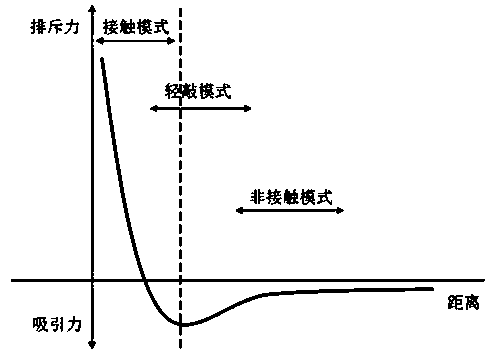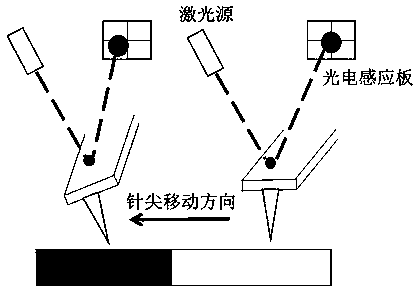Preparation method of carbon material sample for atomic force microscope contact mode characterization
An atomic force microscope, carbon material technology, applied in scanning probe microscopy, instruments, measurement devices, etc. question
- Summary
- Abstract
- Description
- Claims
- Application Information
AI Technical Summary
Problems solved by technology
Method used
Image
Examples
Embodiment 1
[0033] 1) Prepare 0.1 wt% epoxy resin organic polymer solution and let it stand for 24 hours.
[0034] 2) Dip the organic polymer solution with a glass rod to take a small amount of organic solution, coat the highly oriented graphite substrate once (only once), put it in a petri dish, dry naturally, and after removing the solvent, the surface is covered with a layer Flat polymer film.
[0035] 3) Evenly disperse graphene in deionized water, and disperse it ultrasonically for 30 minutes to obtain a dark black dispersion, and the concentration should not be too high.
[0036] 4) Use a dropper to take half a drop of dispersion liquid, evenly flow to the surface of the polymer film, and heat it with a hair dryer on the back of the highly oriented graphite substrate for 10s. Samples such as graphene can be fixed on the film, which can be used in AFM contact mode to stably measure its surface properties, and will not drift due to lateral force.
Embodiment 2
[0038] 1) Prepare 3 wt% polyvinyl alcohol organic polymer solution and let it stand for 24 hours.
[0039] 2) Dip the solution with a glass rod to take a small amount of polyvinyl alcohol organic solution, coat the base of the mica sheet once (only once), put it in a petri dish, let it dry naturally, and after removing the solvent, the surface is covered with a layer of surface The flat polymer film has a surface roughness of about 0.6 nm, such as Figure 4 , 5 As shown, it can meet the requirements of AFM testing.
[0040] 3) Evenly disperse graphene in anhydrous ethanol, disperse ultrasonically for 30 minutes, and obtain a dark black dispersion liquid, and the concentration should not be too high.
[0041] 4) Use a dropper to take half a drop of the dispersion, and evenly flow it onto the surface of the polymer film, and heat it with a hair dryer on the back of the mica sheet for 50s to fix the graphene on the film. The samples made in this way can be used for AFM Its sur...
Embodiment 3
[0043] 1) Prepare 5 wt% polyvinylidene fluoride organic polymer solution and let it stand for 24 hours.
[0044] 2) Dip the organic polymer solution with a glass rod to take a small amount of organic solution, coat the substrate of the silicon wafer once (only once), put it in a petri dish, dry it naturally, and after removing the solvent, the surface is covered with a layer of surface The flat polymer film has a surface roughness of about 0.6 nm.
[0045] 3) Disperse the carbon black evenly in acetone and disperse it ultrasonically for 30 minutes to obtain a dark black dispersion, and the concentration should not be too high.
[0046] 4) Use a dropper to take half a drop of dispersion liquid, evenly flow to the surface of the polymer film, and heat it with a hair dryer on the back of the silicon wafer substrate for 100s. The carbon black sample can be fixed on the film, which can be used in AFM contact mode to stably measure its surface properties, and it will not drift due ...
PUM
 Login to View More
Login to View More Abstract
Description
Claims
Application Information
 Login to View More
Login to View More - R&D
- Intellectual Property
- Life Sciences
- Materials
- Tech Scout
- Unparalleled Data Quality
- Higher Quality Content
- 60% Fewer Hallucinations
Browse by: Latest US Patents, China's latest patents, Technical Efficacy Thesaurus, Application Domain, Technology Topic, Popular Technical Reports.
© 2025 PatSnap. All rights reserved.Legal|Privacy policy|Modern Slavery Act Transparency Statement|Sitemap|About US| Contact US: help@patsnap.com



